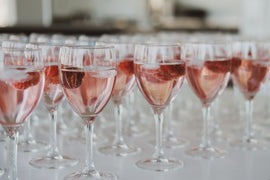I recently came upon an article written by Eddie Osterland, America’s First Master Sommelier. He states, “Most people see wine as a wonderful beverage choice. I see it differently. I see it more as a condiment – a complementary addition to enhance the flavors of a delicious meal – rather than a beverage.” It’s funny but I’ve always seen food as an excellent condiment to wine! Often, I’m choosing the wine first, then deciding what I want to eat with it. In either case there is a synergy that happens between food and wine. The wine enhances the flavors of the food and the food enriches the flavors of the wine, all for the better. It’s better than just the taste of the food or wine alone. You probably have a favorite food and wine pairing. Take a moment to consider: why do you think it works?
Sucesores de Benito Santos’ 2018 Godello
Occupying the northwest corner of Spain, the province of Galicia is nestled snugly between various mountain ranges to the east, the Atlantic Ocean to the north and west, and Portugal to the south. The region has developed in isolation from the rest of Spain, sharing more similarities, both geographically and culturally, to Northern Portugal, than to the rest of Spain. Galicia boasts five denominated wine regions (DOs). Rías Baixas, closest to the Atlantic coast, is the largest and best known of the quintet. Further inland lie the smaller regions of Ribeiro, Ribeira Sacra, Valdeorras and Monterrei. Monterrei is the hottest subregion of Galicia in summer, but the coldest in winter. The Monterrei Valley is often only considered for the cultivation of cereals, fruit trees and other horticultural products, but the Valley is today one of the most dynamic regions in terms of wine production. Like its regional brethren, Monterrei (the “King’s Mountain”) has a long history of viticulture. Winemaking was introduced to the area by the ancient Romans, whose influence is confirmed by the number of presses and vessels that have been dug up here. Monterrei is situated in the Duoro River basin, although it is the Tamega River – a tributary that eventually flows into the Duoro near Marco de Canaveses in Portugal – that is important here. Most vines are planted in the river valleys along the Tamega. Monterrei is divided into two sub-zones: Ledeira de Monterrei (Slopes of Monterrei) and Val de Monterrei (Monterrei Valley). The division is a natural split, largely due to differences in the soil types, from granite to slate to clay. Godello, Treixadura, Albariño and Mencía vines brave the elements on the steep slopes and valleys that overlook the Támega River.
Benito Santos is a central figure in the modern history of Albariño and the Rías Baixas D.O. He began working in his grandfather’s vineyards in the 1930s and made wine for serving in his bar – wines that repeatedly won prizes in the annual Fiesta de Albariño in Cambados. Benito was a man with a dream. He envisioned a day when the world would know and appreciate this noble grape variety. After years of dedication, he founded his own winery in 1979, and he was instrumental in the creation of the Rías Baixas D.O. in the 1980s. The company that now bears his name (Sucesores de Benito Santos) farms three vineyards in the Val do Salnés subzone of Rías Baixas, each of which is next to and named after an ancient church: Saiar, Bemil, and Xoan. All of the vineyards, which are leased in perpetuity, are now certified organic – a rarity in rainy, mildew-prone Rías Baixas – and winemaking uses only native yeasts and minimal sulfur. In 2002, the winery began an extensive renovation, modernization and expansion broadening their production. Godello and Mencía varieties from the DO Monterrei were added to their portfolio.
Sucesores de Benito Santos’ 2018 Godello is made from 25+ year-old vines that are planted on granitic and slate soils. The grapes are hand-harvested with additional sorting at the winery, and then fermented in temperature-controlled stainless-steel tanks. The wine then rests on its lees for three months prior to bottling. The result is a richly-textured Godello with aromas of yellow fruits and citrus blossoms. In the mouth the wine has intense fruity flavors with juicy acidity, good minerality, and excellent balance.
The 2018 Godello makes an ideal pairing for spicy shrimp or chicken. It also pairs well with traditional Spanish dishes: Setas a la plancha–grilled oyster mushrooms doused with a parsley, garlic and olive oil dressing; Almejas a la marinera-clams steamed with a bit of white wine, some olive oil and some diced onion, Pulpo a la Gallega (Galician octopus)-a very spicy dish where the octopus is cooked with paprika, Caldeirada (Galician fish stew)-made with potatoes and a white fish, or tortilla guisada–a potato omelet served in savory tomato sauce.
$20.00/bottle, $216.00/case
Château de Haut-Coulon’s 2015 Cadillac-Cotes de Bordeaux
Bordeaux is a vast wine region of 54 appellations and 13,000 wineries making approximately 60 million cases annually. The vineyards stretch North, South, and East of the city itself, and are split by the huge Gironde Estuary. This then further splits into two famous rivers: the Dordogne and the Garonne. Being the world's largest wine region, there are approximately 120,000 hectares (1 hectare equals 2.47 acres) of vines in Bordeaux. Assuming a planting density of 6,000 vines per hectare (some properties plant 8,000 or even 10,000 vines per hectare,) that makes for at least 720 million vines in Bordeaux alone, all pruned annually, each one by hand. If Bordeaux were a country, it would rank 5th in wine production on its own. Bordeaux can be divided into three principal areas: Right Bank, which includes the appellations of Saint-Émilion, Bordeaux, Fronsac, and Pomerol; Entre-Deux-Mers, consisting of Premières-côtes-de-Bordeaux, Cadillac, and Loupiac: Left Bank, which includes Mèdoc, Saint-Estèphe, Margaux, and Pessac-Lèognan. While most wine drinkers may know of the great appellations within Bordeaux, they may be unfamiliar with the wines from the Côtes de Bordeaux. This hilly appellation, located on the Right Bank, was first formed in 2009 with the union of four regions: Côtes de Blaye, Côtes de Castillon, Côtes de Francs and Côtes de Cadillac. In 2016, Sainte-Foy Bordeaux joined the group. Together, they cover nearly 30,000 acres of vines, and represent 10 percent of the total production of Bordeaux. While each appellation has its own distinct terroir, they do have similarities, particularly their long history, their hilly landscape and their closeness to the Gironde, Garonne and Dordogne Rivers, which affect their climates.
Côtes de Bordeaux Cadillac is the appellation title for Côtes de Bordeaux red wines made specifically in the area around the town of Cadillac, at the southern end of the Entre-deux-Mers district of Bordeaux. Until 2009, these wines were sold under the Premieres Côtes de Bordeaux title. The new AOC is distinct from the sweet white wine appellation Cadillac, which earned the area its original fame. All Côtes de Bordeaux Cadillac wines are red and are made predominantly from Merlot, Cabernet Sauvignon, and Cabernet Franc, with a permitted addition of Malbec, Petit Verdot, and even Carmenère. Merlot is the main variety, producing relatively well-structured wines, which are supple, yet approachable at an early age. Vineyards on the slopes down to the Garonne, with ancient river deposits of sandstone and clay, are better suited to Merlot. While some sites on the top of the plain feature gravelly soils which will favor the Cabernet varieties and produce more-structured wines with higher levels of tannins.
Started in Bordeaux in 1949 by nine siblings, Groupe Castel is now run by Pierre Castel and his family. In France, the group owns 21 vineyards. The beverage giant, which makes beer, wine and soft drinks, expanded into developing markets including Africa, where they built 45 breweries and invested in sugar cane crops to stock their soda business. They now have 1,600 hectares of vineyards in Africa and 17 estates in Morocco, Tunisia and Ethiopia. The group sells 4.6 billion bottles a year and produces 640 million bottles of wine annually.
Acquired by the Castel Family at the beginning of the 1980s, Château de Haut-Coulon is located in the village of Sainte-Eulalie within the Cadilac-Cotes de Bordeaux appellation. It is the smallest of the Castel Group properties with only 3.86 hectares of vineyards planted to Merlot (60%), Cabernet Sauvignon (20%), and Petite Verdot (20%). The vineyards are tightly-planted with a vine density of 7,200 vines per hectare. Haut-Coulon’s soils are remarkably free-draining. With their seams of limestone and montmorillonite clay, they look like the layers of a millefeuille. The sun exposure on their north-facing chalky-clay hillside plays a major role in the quality of Château de Haut-Coulon’s wines.
The 2015 Château de Haut-Coulon is a blend of 50% Merlot, 35% Cabernet Sauvignon, and 15% Petite Verdot. Haut Coulon utilizes innovative vinification techniques, starting with alternating punch-downs with pumping over, all in truncated conical vats. Fermentation is done with temperature control and the wine is then aged in 500-liter barrels (20% new) for 12 months.
The 2015 Château de Haut-Coulon smells deliciously of ripe black plums. It's not too heavy, with plenty of concentrated fruit that is framed by noticeable though nicely reserved tannins. Blackberries and spices coat the palate, easing into a lingering finish with plenty of savory, minerally notes. The wine is youthful but develops nicely as it sits in the glass. The 2015 Château de Haut-Coulon matches very well with the deeply savory tastes you get in foods such as roast chicken, mushrooms, and parmesan. It is delicious with grilled veal, pork or lamb chops especially with herbs such as thyme, rosemary and oregano, steak in a red wine sauce, roast rack or leg of lamb, or caramelized roasted vegetables.
$28.00/bottle, $302.40/case
Find similar articles
bordeauxcabernetfrancegodellomerlotspainWinewine of the monthwine of the month club




